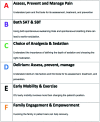Early mobilization in the pediatric intensive care unit
- PMID: 30460183
- PMCID: PMC6212381
- DOI: 10.21037/tp.2018.09.02
Early mobilization in the pediatric intensive care unit
Abstract
Survivors of critical illness often experience multiple morbidities that start in the intensive care unit and impact their quality of life after discharge. Reduced physical function, cognitive decline, feeding disorders, and psychological stress are just a few of the potential complications. Many of these morbidities can lead to a reduced quality of life and lifelong impediments. Early mobilization, an intervention that is intended to maintain or restore musculoskeletal strength in the critically ill, has the potential to also yield positive psychological and cognitive benefits. In adults, early mobilization has been shown to be safe, decrease the incidence of delirium, and decrease length of stay. Early mobilization of the pediatric critically ill patient is still a novel topic with a growing body of research. This article will review the current literature on early mobilization of the pediatric critically ill patient.
Keywords: Critical illness; early mobilization; pediatrics; rehabilitation.
Conflict of interest statement
Conflicts of Interest: The authors have no conflicts of interest to declare.
Figures
References
-
- ICU liberation: Optimizing quality and efficiency of critical care delivery [Internet]. [cited 2018 Mar 30]. Available online: https://www.beckershospitalreview.com/quality/icu-liberation-optimizing-...
Publication types
LinkOut - more resources
Full Text Sources
Medical


